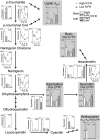Stem transcriptome reveals mechanisms to reduce the energetic cost of shade-avoidance responses in tomato
- PMID: 22872775
- PMCID: PMC3461533
- DOI: 10.1104/pp.112.201921
Stem transcriptome reveals mechanisms to reduce the energetic cost of shade-avoidance responses in tomato
Abstract
While the most conspicuous response to low red/far-red ratios (R:FR) of shade light perceived by phytochrome is the promotion of stem growth, additional, less obvious effects may be discovered by studying changes in the stem transcriptome. Here, we report rapid and reversible stem transcriptome responses to R:FR in tomato (Solanum lycopersicum). As expected, low R:FR promoted the expression of growth-related genes, including those involved in the metabolism of cell wall carbohydrates and in auxin responses. In addition, genes involved in flavonoid synthesis, isoprenoid metabolism, and photosynthesis (dark reactions) were overrepresented in clusters showing reduced expression in the stem of low R:FR-treated plants. Consistent with these responses, low R:FR decreased the levels of flavonoids (anthocyanin, quercetin, kaempferol) and selected isoprenoid derivatives (chlorophyll, carotenoids) in the stem and severely reduced the photosynthetic capacity of this organ. However, lignin contents were unaffected. Low R:FR reduced the stem levels of jasmonate, which is a known inducer of flavonoid synthesis. The rate of stem respiration was also reduced in low R:FR-treated plants, indicating that by downsizing the stem photosynthetic apparatus and the levels of photoprotective pigments under low R:FR, tomato plants reduce the energetic cost of shade-avoidance responses.
Figures






Similar articles
-
Far-red light promotes Botrytis cinerea disease development in tomato leaves via jasmonate-dependent modulation of soluble sugars.Plant Cell Environ. 2020 Nov;43(11):2769-2781. doi: 10.1111/pce.13870. Epub 2020 Sep 4. Plant Cell Environ. 2020. PMID: 32833234 Free PMC article.
-
Mechanisms of far-red light-mediated dampening of defense against Botrytis cinerea in tomato leaves.Plant Physiol. 2021 Nov 3;187(3):1250-1266. doi: 10.1093/plphys/kiab354. Plant Physiol. 2021. PMID: 34618050 Free PMC article.
-
Far-red light effects on plant photosynthesis: from short-term enhancements to long-term effects of artificial solar light.Ann Bot. 2025 Feb 19;135(3):589-602. doi: 10.1093/aob/mcae104. Ann Bot. 2025. PMID: 38946023 Free PMC article.
-
Improvement of tomato salt tolerance by the regulation of photosynthetic performance and antioxidant enzyme capacity under a low red to far-red light ratio.Plant Physiol Biochem. 2021 Oct;167:806-815. doi: 10.1016/j.plaphy.2021.09.008. Epub 2021 Sep 8. Plant Physiol Biochem. 2021. PMID: 34530325
-
Plants under continuous light.Trends Plant Sci. 2011 Jun;16(6):310-8. doi: 10.1016/j.tplants.2011.02.003. Epub 2011 Mar 9. Trends Plant Sci. 2011. PMID: 21396878 Review.
Cited by
-
Shade avoidance components and pathways in adult plants revealed by phenotypic profiling.PLoS Genet. 2015 Apr 15;11(4):e1004953. doi: 10.1371/journal.pgen.1004953. eCollection 2015 Apr. PLoS Genet. 2015. PMID: 25874869 Free PMC article.
-
Changes in light quality alter physiological responses of soybean to thiamethoxam.Planta. 2016 Sep;244(3):639-50. doi: 10.1007/s00425-016-2531-5. Epub 2016 Apr 25. Planta. 2016. PMID: 27114265
-
The Growth-Inhibitory Effect of Increased Planting Density Can Be Reduced by Abscisic Acid-Degrading Bacteria.Biomolecules. 2023 Nov 19;13(11):1668. doi: 10.3390/biom13111668. Biomolecules. 2023. PMID: 38002350 Free PMC article.
-
Ethylene- and Shade-Induced Hypocotyl Elongation Share Transcriptome Patterns and Functional Regulators.Plant Physiol. 2016 Oct;172(2):718-733. doi: 10.1104/pp.16.00725. Epub 2016 Jun 21. Plant Physiol. 2016. PMID: 27329224 Free PMC article.
-
Shade Effects on Peanut Yield Associate with Physiological and Expressional Regulation on Photosynthesis and Sucrose Metabolism.Int J Mol Sci. 2020 Jul 25;21(15):5284. doi: 10.3390/ijms21155284. Int J Mol Sci. 2020. PMID: 32722456 Free PMC article.
References
-
- Ballaré CL. (1999) Keeping up with the neighbours: phytochrome sensing and other signalling mechanisms. Trends Plant Sci 4: 97–102 - PubMed
-
- Ballaré CL, Sánchez RA, Scopel AL, Casal JJ, Ghersa CM. (1987) Early detection of neighbour plants by phytochrome perception of spectral changes in reflected sunlight. Plant Cell Environ 10: 551–557
Publication types
MeSH terms
Substances
LinkOut - more resources
Full Text Sources
Research Materials

